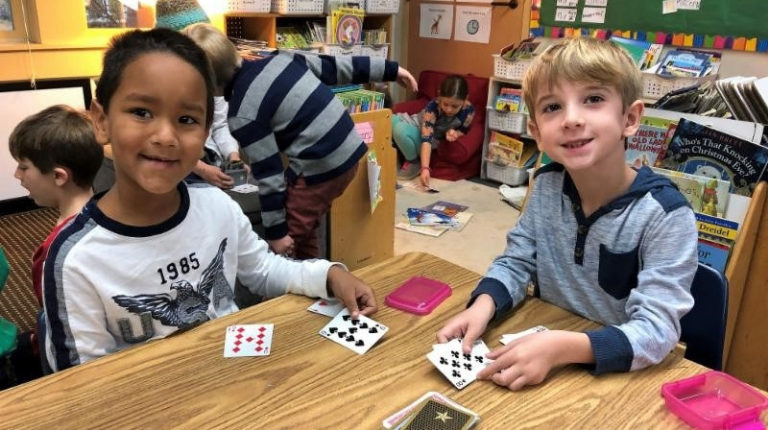When you were growing up, your math learning likely consisted of memorizing facts and practicing procedures the teacher demonstrated for what seemed like a million times. Your homework assignments probably were something like this: “Do the even problems, 1-100, on page 23 of the math textbook.” Today, math education has shifted from teaching the “history of mathematics” – the procedures that someone else discovered works every time – to having children “do” mathematics and think like a mathematician.
“We want students to get a true understanding of the number system by building their number sense,” said Lori Kennedy, Lower Years Assistant Principal. “We want them to think flexibly with numbers, seeking patterns and strategies that always work, and be able to share how they are thinking through numbers and models. Developing number sense gives students more confidence as well as the foundational understandings for the simple arithmetic in elementary classrooms and the more complex mathematics down the line.”
Exploring Why Traditional Math Strategies Work
Kennedy recommends parents read “A Parent’s Guide to Understanding Math Education in Today Schools” by Cathrine Kellison and Catherine Twomey Fosnot. The authors explain that to help students develop number sense, teachers should encourage them to explore WHY procedures work, to find various strategies for solving a problem, and to examine each strategy for its efficiency. They work closely with students, both one-on-one and in groups, to discuss, question, and refine their strategies.
Teaching this way supports students working collaboratively to look at options, exchange ideas, and develop ways to communicate and defend their ideas, the authors note. It also helps them persevere in solving problems and appreciate puzzlement and the fun of ‘cracking’ a problem. These are key skills students need to practice so they are prepared for higher education and ultimately the working world.
Science, technology, engineering and math (STEM) learning is an important part of helping children be prepared for our rapidly-changing world. Math education today makes the mathematical connection between classroom ideas and the real world in which children, teachers and families live and work. It also emphasizes clever mental math computation and focuses to a lesser degree on pencil and paper arithmetic strategies. Finally, it encourages children to model problems, for example with arrays, ratio tables, and number lines.
Building Numerical Fluency
“When I was learning math, the intent of continually practicing was to build efficiency and mathematical fluency,” Kennedy said. “This new framework for math instruction helps students understand math concepts which leads to easier fluency.”
In their book “Developing Numerical Fluency”, authors Patsy Kanter and Steven Leinwand explain that numerical fluency is:
- about understanding, not memorization
- supported by fingers, pictures, and all sorts of materials – multiple representations that best fit individual students’ conceptions
- develops when students communicate their understandings and construct and share their strategies
- developed much more through engaging tasks and activities with rich questions and student discourse than through endless practice.
How to Support Your Child in Learning Mathematics
To better support your child at home, Kennedy recommends parents learn more about numerical fluency themselves and how math is now being taught.
“A Parent’s Guide to Understanding Math Education in Today’s Schools” is written by the authors of the math curriculum Contexts for Learning Mathematics that we use at High Meadows in the Lower Years program,” she said. “It offers tips on helping children with math, information that may strengthen your own math, and examples of both the language and mathematical models we use in the classroom. It’s a great resource for parents to understand the importance of children building their number sense and fluency versus just memorizing facts and practicing problems repetitively.”





